Major Ethnic Groups
The history of peopling of Jammu and Kashmir State is a record of constant impulses of immigration from the north-west, west, south and east directions. The alien races, ethnic groups and various religions have influenced the cultural ethos and mode of life of the people of this region.
Ethnic group, in the opinion of Jordon is a group of people possessing a common ancestry and cultural tradition with a feeling of belonging and cohesiveness, living as a minority in a larger society. Each social group is the keeper of distinctive cultural traditions and the nucleus of various kinds of social interactions. An ethnic group provides not only group identity, but also friendship, marriage patterns, business success, and the political power base.
The mosaic of ethnic group in Jammu and Kashmir State is complex and the race structure cannot be explained without understanding the pre-historic movements of people. In the process of peopling of the region, the Dards in the north-west, the Ladakhis in the east, the Gujjars and Rajputs in the south and Paharis in the south-east have closely influenced the existing ethnicity of the people. The racial composition of the State was also influenced by the immigrants from the territories of Turkmenia, Tadzkistan, Uzbaikistan, Kazakistan, Georgia, Azerbaijan (U.S.S.R.) Turkey, Iraq, Iran and Afghanistan.
The various ethnic groups of the Jammu and Kashmir State though intermingled have their areas of high concentration. For example, Kashmiris are mainly concentrated in the Valley bottom; Dards occupy the valley of Gurez; Hanjis are confined to water bodies of Kashmir; Gujjars and Bakarwals are living and oscillating in the Kandi areas; Dogras ocoupy the outskirts of the Punjab plain, while Chibhalis and Paharis live between Chenab and Jhelum rivers. Moreover, there are numerous small ethnic g}oups like Rhotas, Gaddis and Sikhs which have significant concentration in isolated pockets of the State.
Kashmiris
Kashmiris are well spread in various parts of the State but their major concentration lies in the Valley of Kashmir, Kishtwar, Bhadarwah, Doda and Ramban tehsils of the Jammu Division.
'Kashmiri' is a wide term which has loosely been applied for several streams of immigrated mainly from Turkey, Iran, Central Asia and Afghanistan, and settled in the valley. There is a close bearing of the Indo-Aryans on the racials composition of the Kashmiris. In fact, the Indo-Aryan religions and languages have substantially affected the mode of life of the Kashmiris. The influence of Sanskrit on Kashmiri language is strong and cogent to this day. Moreover, Kashmir has also received racial impulses from Indo-Greeks which have influenced the race structure of the people considerably. The influence of Dards, Ladakhis and Punjabis has also moulded the ethos of Kashmiri culture.
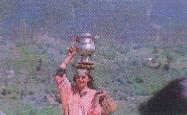

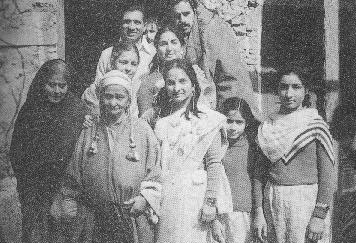
Kashmiris are broad shouldered and usually of medium to tall stature. They are much dolichocephic, have a well developed forehead, a long narrow face, regular features and a prominent straight and finely cut nose. They wear short pyjamas, a long loose large sleeved gown locally known as Pharan, and a skull cap. In intellect they are superior to their neighbours and efficient in business. In disposition they are talkative, cheerful and humerous.
Most of the Kashmiris live in villages and are dependent on agriculture. Paddy, orchards, saffron are the main crops grown by them while the urban Kashmiris are engaged in business, tourism, hotel-management, carpet making, silk industry, shawl-making, wood work, pieper-mache and several other handicrafts.
Dards
Dards have a long history. Ptolemy in his book 'Almagast' has used the word Daradrai for Dards of the western Himalayas. Before embracing Islam, they were the followers of Budhism and Hinduism. At present their major concentration lies in Dardistan (Derdesa), the area to the north of Kashmir Valley, especially in the catchment of Kishanganga north of Sardi, Gurez and Tilel.
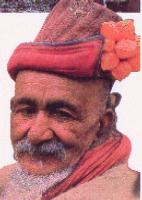
In the opinion of Leitner, Dards belong to Aryan stock. This opinion is also endorsed by Ray who states that the Dardic Aryans parted from the main Aryan mass just after their enterence into India. Dardic Aryans then colonised the Pamir region from where they spread to Chitral and Gilgit.
In physical appearance the Dards are broad shouldered, moderately stout-built and have well proportionate bodies. In face they are not handsome, their hairs are usually black but sometime brown, in complexion they are moderately fair. Their eyes are either black or hazel. They are known for their ferocity. In the social hierarchy they are divisible into: (i) Renue (ruling class), (ii) Shins (religious sect), (iii) Yashkun (cultivators) and (iv) Dum (menial class). Dards are dependent on agriculture, pastoralism, cottage industries and trade.
Ladakhis
Ladakhis have been named as the people of snow-living in an arid plateau, surrounded by mountains, where cultivation of crops is hampered by severe cold and non- availability of water for irrigation. Ladakhis are a mixture of Mongoloid and Aryan races. The Aryans who settled originally in the sub-continent's northern parts were the early Budhist people from Kashmir and the Dards from Gilgit. The Mongolian stock is traced to Tibet, from where the shephereds and nomads came to the valleys of Ladakh to graze their flocks. The present day population of Ladakh is the result of blending together of Dards and the Mongolians.
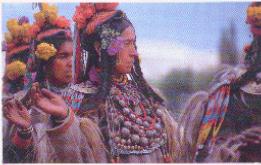
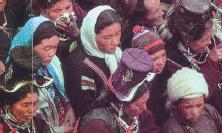
The recent papulation data reveals that Ladakh is inhabited by the Budhists, the Muslims, the Hindus and the Christians. The Budhists are mostly the decendents of the Mongolians and bear a close affinity in features with the Tibetans. They are reputed for religious tolerance, honesty and hard work. There are some families even now, members of which follow different religions and yet live in peace. Where the husband wife profess different faiths, the male child is regarded as a member of the community to which the father belongs while the female child is admitted to the religion of her mother.
Budhism does not recognise any caste or racial distinction, but some differentiation is made on the basis of social and occupational considerations. In any case the Budhists may be classified among three principal categories, namely, Rigzang, Mangriks, and Rignu. Rigzang is the upper class. Mangriks who constitute the middle class consist of Lamas, Unpos, Nungsu, Lorjo, and Thakshos. The lowest class which is known as Pignu includes Beda, Mou, Garra, Shinkhan and Lamkhun etc.
Ladakhis are truthful, good natured, cheerful, friendly, industrious and honest. They are seldom angry and soon ready to become friends. In conversation they are very polite. Ladakhis are well built and have developed sufficient resistence to work even when the temperature is as low as -25¡C.
The population of Ladakhis is not increasing steadily, probably owing to the prevalence of polyandry and partly on account of climatic and economic conditions which have been operating against the development of population and its increase in number.
Dogras
On the outskirt of the Siwaliks facing the plain of Punjab is the habitat of Dogras a distinctive ethnic group of Jammu Division. There is controversy among the social anthropologists about their origin. The major concentration of Dogras however, occurs between the two holy lakes i. e. Saroinsar and Mansar. Lake Saroinsar is at a distance of 38 kms. to the east and Mansar 64 kms to the west of Jammu city.
In the opinion of some social anthropologists 'Dogra' is a corruption of the Rajasthani word 'Dungra' means 'hill' and when the people of Rajasthan migrated in the hilly tracks under drought conditions the Rajputs gave this name to the people of hilly country, Stein opines that the name 'Durgara' is probably a tribal designation like 'Gurjara' - original of the modern Gujjar, and similarly the word 'Durgara' has been derived from Durgara' through Prakrit Dogra.
Whatsoever the controversy about the origin of the word Dogra may be they belong to the Aryan race and speak the Dogri language. Most of them have Brahmini path and have the sects of Varnashram. A substantial section of the Dogras embraced Islam during the 16th and 17th centuries. At the time of partition of the Sub-continent most of the Muslim Dogras migrated to Pakistan.
In appearance Dogras are short statured, slim and have high shoulders. Their complexion is wheatish, silghtly hooked nose, brown eyes and jet-black hairs. The lower castes of Dogras in general have blackish complexion.
Hanjis
Hanjis - the dwellers of water, constitute a significant ethnic group in the valley of Kashmir. They are mainly confined to the Dal, Wular, Anchar lakes and the Jhelum river, especially between Khanabal (Ananatnag District) and Chattabal (Srinagar District).
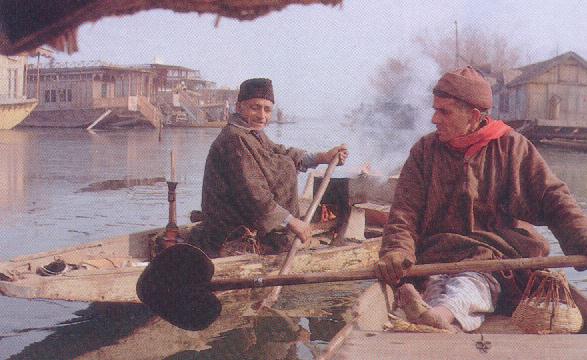
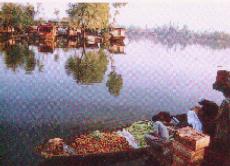
There is not unanimity of opinion amongst the scholars about their arrival in the valley of Kashmir. They, however agree in saying that 'Hanjis' belong to one of the ancient racial groups who were essentially Nishads (boatmen). Some of the Hanjis claim themselves as the descendents of Prophet Noah. There are historical evidences showing that Raja Pratap Sen introduced boatmen from Sangaldip (Sri Lanka). It is believed that before their conversion to Islam, they were Kashtriyas.
Hanjis are sturdy, hard working active people with great imagination. On the basis of occupation and social status Hanjis are divisible into: (i) Demb- Hanz (vegetable growers), (ii) Gari-Hanz (water-nuts gatherers), (iii) Gad-Hanz (fishermen), (iv) Mata-Hanz (who deal in wood), (v) Dunga-Hanz (owners of passenger boats), (vi) Haka-Hanz (collectors of wood from water bodies), (vii) Bahatchi-Hanz (who live in Bahatch boats), (viii) Shikara-Hanz (who ply Shikara boats), and (ix) House- boat Hanz. The various Hanji groups use boats of different types, shapes and sizes, e. g. Bahatch, Khoch, Demba-Nav, Kara Nav, War, Tchakawar, Parinda and Houseboat. The type of boat which a Hanji owns and uses for earning his livelihood or the product he deals with to a great extent, denotes his class and social status.
The sex-ratio of Hanjis is about 892 as against 936 the national level and 899 the state average. The low sex ratio shows that the males are better cared and well fed than females. In fact, the females are still a neglected lot and are not properly cared like the underdeveloped patriarchal societies.
A field study conducted reveals that the literacy rate in Hanji's is only 12 per cent. The proportion uf literate males and females being 20.5 and 3.7 per cent respectively. Nearly 34 per cent of the total population of Hanjis is engaged in various type of productive activities, while the remaining 66 per cent is dependent population, belonging to juvenile, Senile and household female population.
Hanjis in general do not have fixed incomes. Their income varies from month to month and season to season. It is more true of those who are engaged in hotal management and houseboat industry. In fact, tourism is an imporlant activity on which many of the Hanjis are dependent. Tourism in itself depends on many other factors like the number and pattern of tourist inflow, the weather conditions and the political situation of the State.
Hanjis, a peculiar ethnic group attached to water in general is not developing at the desired rate. The living conditions of Gad- Hanjs and Demb-Hanjs are poor and unhygienic, while those who are houseboat owners have better income and social status. Some pragmatic planning is to be made for the socio-economic upheaval of the Hanjis of the State.
Gujjars and Bakarwals
Gujjars and Bakarwals constitute a significant proportion of the population of the State. In general, they have nomadic character and largely depend on flocks and cattle keeping for thier livelihood.
The early history of Gujjars and Bakarwals is obscure. There are several theories about their origin. According to one school of thought, before their arrival in the sub-continent they were the inhabitants of Georgia (Gurjia) a territory situated between the Black sea and the Caspian Sea in the Soviet Union. Under certain push and pull factors they left their abode and through central Asia, Iraq, Iran and Afghanistan crossed the Khyber Pass to enter the Subcontinent of India. In the Sub-continent making a southward march through Baluchistan- they reached Gujrat. Most probably in the 5th and 6th century A.D. at the occurrence of some serious droughts they moved out of Gujarat and crossing Rajasthan and Punjab entered the green pastures of the Siwaliks and the Himalayas. Having their place of origin as Georgia and moving towards the Sub- continent of India they named several settlements after their name, e.g. Gujar (Central Asia), Juzrs (Gurjara), Gujrabad, Gujru, Gujristan, Gujrabas, Gujdar-Kotta, Gujar-Garh, Gujarkhan, Gujranwala in Iran, Afghanistan, Turkmenia, Pakistan and India. Cunningham (1970) is however, of the opinion that the Gujjars are the descendent of Kusham and Yachi Tribes which are considered to be the tribes of Eastern Tartars (U.S.S.R.).
The diffusion and spread of Gujjars in the State of Jammu and Kashmir is not known with certainty. When the Gujjars of Jammu and Kashmir are asked about their place of origin, they simply say that their forefathers had migrated from Gujarat and Rajputana (Rajasthan). The arrival of Gujjars in Jammu and Kashmir is attributed to the outbreak of devastating droughts and famines in Rajasthan, Gujarat and Kathiawad. There are archaeological evidences to prove that there was a spell of dryness in the 6th and 7th centuries in Rajasthan and Gujarat which led to the outmigration of these people (Gujjars), who alongwith their cattle entered the pastures of the Siwaliks and the Sub-Himalayas. The 'Gujri' language is now recognised to be a form of Rajasthani language, which supports the hypothesis that Gujjars have outmigrated from Rajputana (Rajasthan).
The major concentration of Gujjars lies in Jammu, Rajouri, Udhampur, Poonch, Uri, Ganderbal, Anantnag, Daksum, Narang and the Kandi areas of the Jammu and Kashmir Divisions. Although some of them have started developing land connections, they are essentially cattle rearers and a section of them - Bakarwals regularly oscillates between the southern slopes of the Siwaliks and the Margs (Alpine-pastures) of the Central Himalayas.
Jn the State of Jammu and Kashmir the Gujjars, on the basis of their occupations and settlements are classified as (i) cultivators who have sedentrized themselves in the sidevalleys, and (ii) the Gujjars who practice transhumance. The second category is further sub-divided into Dodhi-Gujjars (milk-man) and Bakarwals Gujjars (who rear sheep and goats).
The houses of the Gujjars and Bakarwals are locally known as Kothas and Bandis. It is generally a mud-house against the slope of a hillock. The walls are devoid of any ventilation except a small entry door. In one of the walls there is a small hole which is the only outlet for all types of bad gasses and smoke. The shelter though unhygienic protects them and their cattle from severe colds of December, January and February.
The Gujjars and Bakarwals in the State are the followers of Islam, excepting a few who are settled io Bimber, Mirpur and Rajouri. The Gujjars, because of their strict re]igious adherence, have emerged as the most outstanding tribe who are trusted for their honesty.
So far as the dress is concerned, the males wear a long shirt and a trouscr as per the tenets of Islam. Besides, they wear a turban of a peculiar style. The ladies usually wear a long shirt and Shalwar with a cap or Dupatta on their head. Though Purdah system among ladies is not observed, they avoid to face the strangers.
Gujjars are known for their hard work and gentle nature. Rearing of cattle horses, goats and sheep is their main occupation. They have simple food habits. Maize, milk and milk products are the main ingredients of their diet. They usually start their day with a glass of milk and Chapatis (bread) of maize. The same food is being repeated at lunch and dinner. They do not use any type of toxic drinks as taking liquor is prohibited in Islam. Even tea is not consumed by all the Gujjars.
The Gujjars and Bakarwals have no written language and no history beyond word-of-mouth tales and traditions. They have no art beyond traditional tribal songs and the simple tribal patterns they weave into their clothes. Although they live on products of their flocks yet some of them cultivate little maize on the slopes in the narrow valleys with spade and hoe. They donot use vehicular transport instead they use draught animals. The assets and resources vital to them are pasture lands, migration routes and water-resources. These resources and assets are owned commonly by the tribes and maintained collectively. They have a subsistence type of economy and try to produce everything they need in their daily need.
Excerpts from:
Geography of Jammu & Kashmir State
by Majid Husain
Rajesh Publications, New Delhi-110002



